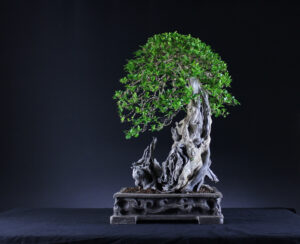/
Deciduous and Broadleaf Bonsai cannot be repotted at any time of the year; for the majority of species, there is a small period of time during the Spring where the roots can be disturbed and pruned with reduced risk of danger to the tree’s health.
Though there are tree species that can be repotted at other times of the year, the purpose of this article is to describe and highlight the best time for repotting the typical deciduous bonsai in Spring.
It is well known (and is frequently referred to in the Species Guides at Bonsai4me.com) that bonsai should be repotted ‘when the buds start to extend’, but, what exactly does this mean and exactly when does this happen?
It is not possible to specify exact calendar dates for repotting. Different tree species require repotting at slightly different times and different trees of the same species can be ready to repot at slightly different times, even those grown in exactly same climate.
Different climates can dramatically effect the exact date of repotting; repotting time in Florida will take place weeks before repotting in New York.
However, nearly all tree species follow the same series of stages of bud growth in Spring and these can be used to identify the best time to repot your bonsai.
Why Repot in Spring?
As temperatures slowly rise in early Spring, the roots of a deciduous (or broadleaf) bonsai slowly become active. The energy resources of the tree that have been stored in the roots over winter begin to move back up into the tree. As they do, the dormant buds on the branches (produced in late Summer and Autumn of the previous year) begin to swell.
This is the signal that the tree is beginning to come out of dormancy. As ambient temperatures continue to rise through the next weeks, move of the tree’s stored energy moves from the roots, up into the tree in readiness for the explosion of new growth as the tree comes into leaf. At this point, the roots stop being an energy store and their primary function is to supply the newly opening leaves with moisture from the ground.
This process can be followed from start to finish by observing the state of the buds visible on the branches on the bonsai. This process can be broken down into 4 stages;
The 4 Stages of Spring Buds
Stage One, Winter Buds: The Winter Buds on most trees are tiny and are typically colourless. At this point the roots are also dormant. The majority of the trees resources are contained within the roots.
Stage Two, Swelling Buds/Bud Swell: A period of time after the roots begin to wake in early Spring, the buds on the branches will begin to swell. In many (but not all) species, the swelling buds will have a stronger colour than those that are still dormant (Winter buds).
It is at this stage that new adventitious buds can appear on the trunk and existing branches of the tree.
Stage Three, Extending Buds/Bud Extension: The buds will lengthen, take a stronger colour and in many cases appear to be on the verge of opening. By this point the majority of the tree’s resources are no longer in the roots but in the above ground parts of the tree.
This is the best time to repot and root prune as the roots are very active and can repair themselves rapidly, and the majority of the trees resources are contained in the tree. In other words, pruning and removal of the roots will not deplete the tree of energy.
Stage Four, Bud Burst/Bud Opening: The buds open and the tiny new leaves begin to appear. Repotting must be finished by now.
Identifying the 4 Stages
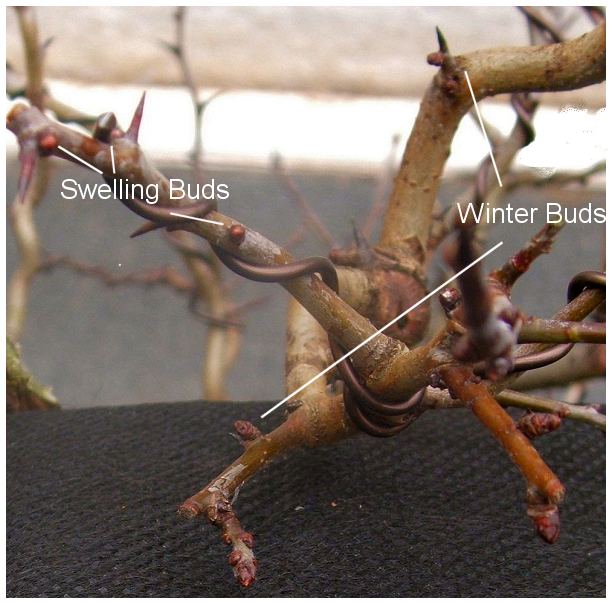
This image of part of a Hawthorn (Crataegus) was taken mid-February in the UK. The swelling buds have brighter, more colourful tips than the dormant buds.
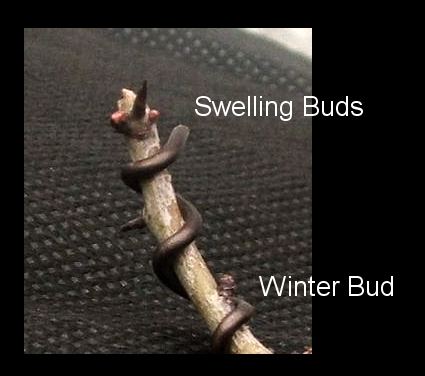
Not all the buds on any one tree will all change from one stage to another uniformly. The tendency of most trees is that the apical buds (those on the tips of branches and in the higher areas of the tree) will always progress more quickly than buds on the inner and lower branches. This Hawthorn branch has 2 swelling buds at the tip and one bud lower down that is still dormant.
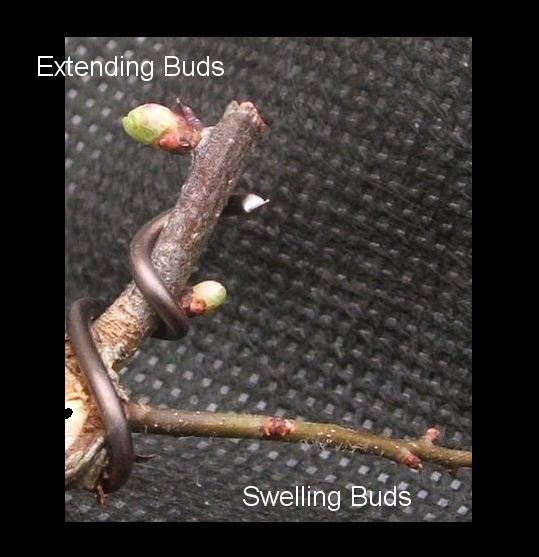
This Hawthorn now has swelling buds all over the branches and a few extending buds. These will begin to open soon and repotting must be carried out.
So During Which Bud-Stages Can a Bonsai be Repotted or Root pruned and When is the Best Time?
Stage One: Dormant Buds.
When the buds are dormant, the roots are also dormant. During this time the tree can be lifted from the ground or its current pot, bare rooted if necessary and repotted.
However, during this time, rootpruning will remove some of the stored energy of the tree and this will affect the growth rate of the tree during the forthcoming growing season. Any damage to the roots (either accidental tears, wounds or pruning cuts) will not be repaired until the roots are more active, leaving the possibility of dieback, loss of the root or even the possibility of infection to the site.
Trees can, and are, collected and root pruned at this time with no obvious ill-effect but there are risks to the health of the tree (that increases according to the amount of the root system that is removed).
Stage Two: Swelling Buds.
During this time the roots are coming out of dormancy but do not have to support any foliage and so can still be disturbed.
Repotting and rootpruning can be carried out safely. The closer the tree gets to Stage Three the better as repotting early will deprive the tree of some energy. However, those enthusiasts with large collections and with many tree trees to repot in a short period of time, will typically start early and repot trees that have many Swelling Buds.
Stage Three: Extending Buds
The very best time to repot and rootprune is as soon as extending buds are visible, typically in the upper branches of the bonsai. The roots are active and will repair any damage or pruning wounds quickly, the majority of the tree resources are above ground and the roots are not yet required to support any foliage.
Be warned; the extending buds stage can last a relatively short period of time!
Stage Four: Opening Buds
The majority of tree species must be repotted and rootpruned by this time or they should be left until the following year. As the first opening buds appear, the roots are required to supply moisture to the new foliage and should not be disturbed!
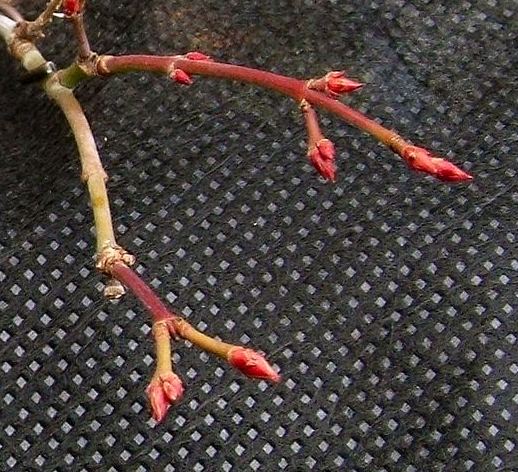
These Acer palmatum Kiyohime buds are in the Swelling Buds- Stage Two phase though the buds at the tips will begin to extend soon.
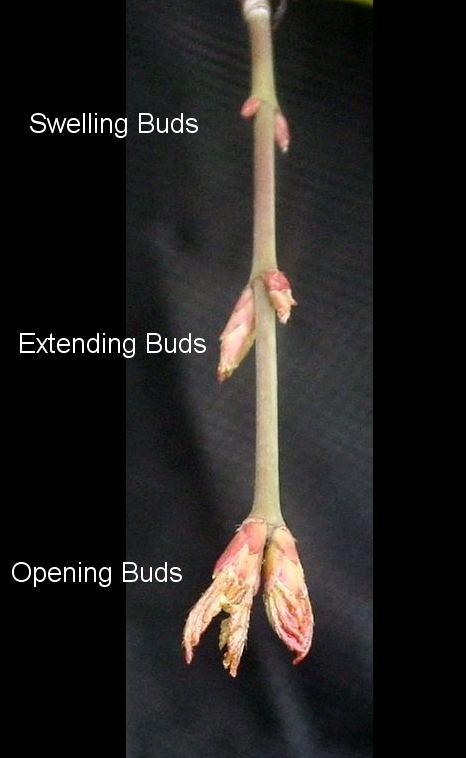
Elsewhere on the same tree, the first two opening buds are found, the tree must be repotted today or left until next year. Here it is very clear that the apical buds at the tip of the branch have progressed quicker than the other buds. It is when these apical buds begin to open that repotting should finish. Some weaker buds on the insides of the branches will remain at Stage One or Two and not reach the stage of Extending or Opening.
Further Notes on Spring Buds and Repotting Times
It is not easy to immediately identify the different stages of Spring Buds until you are familiar with a particular species, as their appearance differs from species to species. However, the basic descriptions of a winter bud, a slightly swollen bud, a lengthening bud and an opening bud does hold throughout all species. If you observe all of the buds on any particular tree, you should be able find and compare examples of at least one or two of the 4 stages, sometimes with 3 or 4 of the stages occurring on just one branch (like that of the Kiyohime pictured above).
Repotting can be safely carried out when the buds are swollen and extending, repotting is best carried out when the buds are extending.
Repotting can be carried out when the buds are dormant but will result in a loss of vigour in the tree until it recovers the ‘energy’ lost from the roots. For this reason, winter repotting (repotting when the buds are still dormant) is not advised.
There are exceptions to these rules but as a fail-safe and general indicator, repotting should not be carried when the buds begin to open



